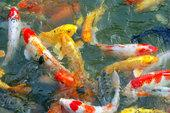 Koi Clay (Bentonite)
Koi Clay (Bentonite)
Bentonite, also known as montmorillonite clay or Koi clay, is used in Koi ponds for various reasons. It is available for water gardening in powder form. Bentonite has coagulating properties, so it will absorb any fine particles that are suspended in the water and it will settle on the bottom of a pond or a filter.
Adding bentonite to a Koi pond is also beneficial to a Koi's immune system, for it has many good minerals in it. Koi get all of their nutrients either from the food they eat or from the water directly. Bentonite can even be added to Koi food to make it have a greater mineral content.
Koi clay (bentonite) can also be used to remove string algae from a stream. Take some of the clay, spread it over where the string algae is growing and it will detach it from the stream bed.
Bentonite is also used as a liner for mud ponds. It is moved in the pond hole with a bulldozer and then tamped until it is about a foot thick so that it forms a waterproof layer.
Bentonite is a rock that is made of claylike minerals. The most common clay minerals in bentonite are members of the smectite group (mostly montmorillonite); other components of bentonite include biotite, feldspars, illite, kaolinite, quartz, and volcanic glass. There are two types of bentonite: swelling bentonite, which is also called sodium or western bentonite, and non-swelling bentonite, which is also called calcium, or southern, bentonite. Both types formed through the alteration of volcanic ash that was deposited in a marine environment. Bentonite is mined mainly in the Western United States and Greece. Most of the bentonite mined in the United States is used in oil and gas well drilling.
